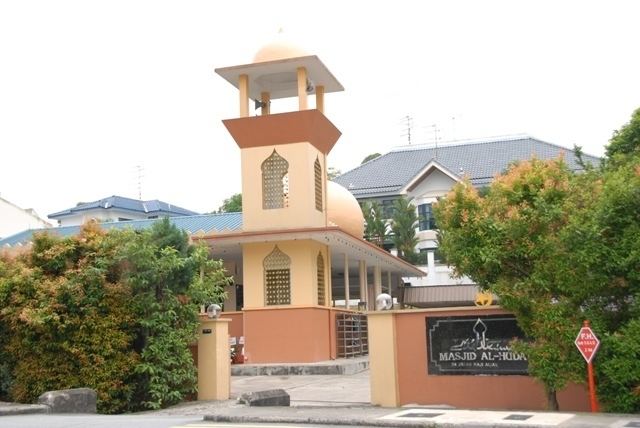 | ||
Masjid Al-Huda (Al-Huda Mosque) is a mosque in Singapore located in the Bukit Timah area, at Jalan Haji Alias, off Sixth Avenue.
Contents
In the past, this old-generation mosque served the needs of residents living in the Malay kampung near Sixth Avenue, Bukit Timah. Built in 1966, the mosque, which can accommodate up to 400 people, has undergone several renovations. Its history, however, dates back to the early years of the 20th century.
With resettlement, the mosque now serves the workers in Bukit Timah area and some residents nearby. Its activities are confined to daily and Friday prayers as well as celebrations of Islamic festivities. With a decline in the population of Muslim residents in the vicinity, the mosque however, still receives a steady flow of worshippers and visitors from time to time.
Land
Masjid Al-Huda sits on wakaf land said to be originally owned by a Hindu moneylender in the early years of the 20th century. In 1905 the land was entrusted to the family of Syed Ahmad Lebbai to be used for a mosque. On 24 February 1925, the family of Syed Ahmad Lebbai represented by Mohamed Yoosof bin Mohamed Kassim and Adamsaiboo bin Madar in turn entrusted it to the family of Haji Dolhalim bin Abdullah (Karto) represented by Haji Abdul Rahman bin Abdul Aziz, Haji Ahmad bin Haji Dolhalim and Haji Mohamed Fathaly bin Haji Dolhalim.
In 1957 new trustees were appointed to replace those who had died. This took place on 26 November 1957 and the following persons were appointed: Haji Ahmad bin Haji Dolhalim, Abdul Aziz bin Haji Abdul Rahman (Amir), Mohamad Said bin Haji Ahamad, Abu Bakar bin Haji Abdul Halim, Haji Mohamed Amin bin Ihsan and Ustaz Ahmad Son Haji bin Mohamed.
In 1968 when the Administration of Muslim Law Act came into effect, all mosques and wakaf lands in Singapore fell under the administration of the Majlis Ugama Islam Singapura (MUIS) or Islamic Religious Council of Singapore. The responsibilities of the trustees were thus transferred to MUIS, which in turn appointed a mosque management board to manage the mosque.
Humble beginnings
Prior to 1925, the mosque was a small wooden structure which served the religious needs of the largely Malay-Muslim villagers residing in the Bukit Timah vicinity. In 1925 the trustees of that time replaced it with a larger mosque made of wooden structures and styled with a close resemblance to the traditional Javanese mosque as most of them hailed from that country. The roof was said to be double layered and the doors collapsible. The mosque looked beautiful compared to the other surrounding village houses of that era. It was named Masjid Kampong Coronation in conjunction with the name of a nearby main street. The locals, however, preferred to call it Masjid Kampong Tempeh due the its location in the middle of this village (kampong in Malay). There were a few other kampongs in this vicinity, namely, Kampong Banjir, Kampong Cantik and Kampong Holland. The mosque served as a major place of worship for the Muslim villagers residing in this area.
Concrete building
In 1960 the desire of the villagers to rebuild the mosque brought about the formation of a mosque-building committee led by Haji Anang bin Abdul Manan. He was assisted by a few other people, including Haji Ahmad Dahlan, Haji Ahmad (Putih), Haji Abdul Karim (Kiyai Karim), Haji Ahmad Sirat (Campbel), Haji Buang Ishak, and Haji Mustajab Haji Johari. They began fund-raising efforts to build a new concrete mosque in this year. The passion to build a new mosque created a great sense of responsibility and continuous efforts by the villagers of Jalan Haji Alias, Jalan Siantan, Jalan Lim Tai See and the nearby villages. Aside from generous donations and monthly contributions, a few street peddlers, especially Wak Karmo, Wak Saidi and Wak Haji Bajuri, solicited donations from their customers and handed them to the mosque committee at the end each business day. With their efforts and prayers, a new concrete mosque was finally completed in 1966. This new mosque, which was of the traditional Malay village style, looked relatively grand compared to the other surrounding houses in the village which were all constructed of wooden structures.
New name
The mosque retained its old name until the 1970s when a new mosque management committee was elected, led by the late Mustafa bin Haji Ahmad and assisted by Haji Kamsin Pamer, Haji Fadzuli Haji Bajuri, Ibrahim Majid, Noordin Suhud and Hassan Sultani. It was during their tenure that the name of the mosque was changed to Masjid Al-Huda. They also brought about some changes in the style of management of the mosque, and successfully conducted weekly religious classes with overwhelming response during the 1970s and 1980s.
Spiritual getaway in the suburbs
With the gradual development of the area beginning in the late 1980s and the relocation of the villagers to modern public housing estates, the area was transformed into a suburb of posh private residential buildings and small but exclusive condominiums. As time went by, some renovations to the mosque were undertaken to cater to the needs of the worshippers and activities that were organised. The original asbestos roofing was replaced in the 1990s with metal roofing due to leaks. Still, many other original features of the mosque building like the minaret, dome and mihrab (niche in the wall) are intact. Apart from serving the needs of Muslims working and living in the vicinity, Al-Huda Mosque now also stands as one of the last physical reminders of the Malay villages or kampongs that once existed in the Bukit Timah area. Muslim travellers passing by the area often take the time to perform their prayers or just to pause away from the hustle and bustle of the city. Now in modern times, with its peaceful and tranquil surroundings, this old-style mosque has become a spiritual getaway in the suburbs.
